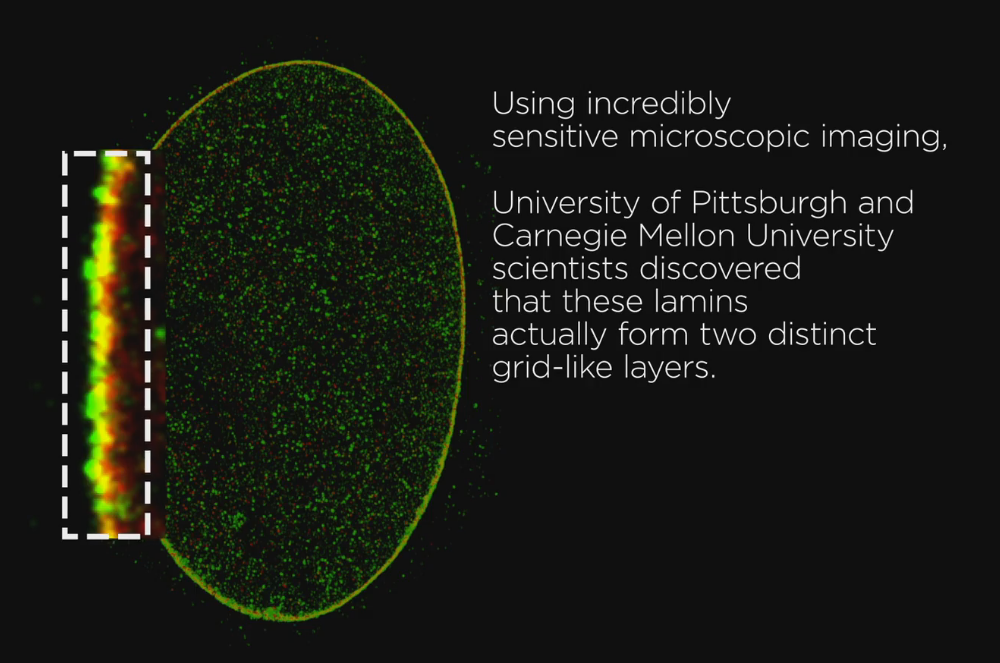|
|
Developmental Biology - Cellular Structure
NEW - Double Walled Nucleus?
Structure of the nuclear envelope gives clues to how cells squish through narrow openings without springing a leak...
Our cells sometimes have to squeeze through pretty tight spaces. And when they do, the nucleus of each cell being squeezed, must go along for the ride. Using super-sensitive microscopic imaging, a team of scientists from the University of Pittsburgh and Carnegie Mellon University made a fundamental discovery about the structure of the nuclear envelope.
The findings give tantalizing clues to how cells squish through narrow openings without springing a leak, and could be key to untangling mechanisms in several genetic diseases. The work is published in the Proceedings of the National Academy of Sciences or PNAS.
"It's quite the serendipitous discovery. Just like everyone else, I thought we knew how the cellular nuclear envelope was organized. But as we took a closer look while investigating a genetic condition, we found that there was far more to the story."
Quasar Padiath MBBS PhD, associate professor in Pitt Graduate School of Public Health in the department of Human Genetics, and one of the senior authors of the research.
Every animal cell contains a nucleus, home to the majority of its genetic material. Lining the interior of the membrane encasing the nucleus is nuclear lamina, a scaffold giving the nucleus its spherical shape. Scientists had previously shown lamina as a tangle of filaments of protein called lamin A and lamin B.
Padiath teamed up with Yang Liu PhD, associate professor in Pitt's departments of medicine and bioengineering, to take a closer look at nuclear lamina. Liu investigates a fatal genetic condition called autosomal dominant leukodystrophy with autonomic disease (ADLD). ADLD patients' have extra copies of a gene coding for lamin B1, a subtype of lamin B. The scientists first looked at the lamina in normal cells using a super resolution imaging technique called "stochastic optical reconstruction microscopy" (STORM).
To their surprise, they observed there are actually two distinct meshworks - an outer and more loosely woven layer of lamin B, and an inner and tighter layer of lamin A.
"It is truly remarkable that STORM is able to visualize such a microscopically small separation between lamin A and B1, never seen with conventional light microscopy," says Liu, also a researcher at the UPMC Hillman Cancer Center.
In collaboration with Kris Dahl PhD, professor of chemical engineering who studies the mechanics and architecture of nuclear membranes, Padiath's team imaged nuclei under varying degrees of pressure. They saw when a cell is compressed, the outer layer of loosely woven lamin B1, thins out. This allows the lamin A layer to bulge out.
"For me, this process is similar to one of my knitting projects. Based on the holes between the stitches and the thickness of the yarn, you can predict the stiffness of the material."
Kris Noel Dahl PhD, Department of Biomedical Engineering, Carnegie Mellon University, Pittsburgh, Pennsylvania, USA.
The scientists believe flexibility in compression of the lamina layers are needed for the nuclear system to function properly. Flexibility allows nuclei to relieve pressure caused by biologic functions such as moving through very thin blood vessels, or any narrow openings, avoiding damage to nuclear contents. ADLD patients typically live into their 40s and 50s before experiencing symptoms eventually leading to fatal brain degradation. The disorder involves having extra copies of the lamin B1 gene. So, Padiath will continue exploring how this extra gene impacts brain cells in middle age.
"Now that we can look at the nuclear architecture in such exquisite detail, we can start asking, 'How does it change in ADLD and other lamina diseases, particularly with aging?'"
Padiath saidQuasar S. Padiath PhD, Department of Human Genetics, University of Pittsburgh, Pittsburgh, Pennsylvania, USA.
Significance
The nuclear lamina is an integral component of all metazoan cells. While the individual constituents of the nuclear lamina, the A- and B-type lamins, have been well studied, whether they exhibit a distinct spatial organization is unclear. Using stochastic optical reconstruction microscopy, we have identified two organizing principles of the nuclear lamina: lamin B1 forms an outer concentric ring, and its localization is curvature-dependent. This suggests that a role of lamin B1 is to stabilize nuclear shape by restraining outward protrusions of the lamin A/C network. These findings provide a model for the nuclear lamina that can predict its behavior and clarify the distinct functional roles for the individual lamina components and the consequences of their perturbation.
Abstract
The nuclear lamina is an intermediate filament meshwork adjacent to the inner nuclear membrane (INM) that plays a critical role in maintaining nuclear shape and regulating gene expression through chromatin interactions. Studies have demonstrated that A- and B-type lamins, the filamentous proteins that make up the nuclear lamina, form independent but interacting networks. However, whether these lamin subtypes exhibit a distinct spatial organization or whether their organization has any functional consequences is unknown. Using stochastic optical reconstruction microscopy (STORM) our studies reveal that lamin B1 and lamin A/C form concentric but overlapping networks, with lamin B1 forming the outer concentric ring located adjacent to the INM. The more peripheral localization of lamin B1 is mediated by its carboxyl-terminal farnesyl group. Lamin B1 localization is also curvature- and strain-dependent, while the localization of lamin A/C is not. We also show that lamin B1’s outer-facing localization stabilizes nuclear shape by restraining outward protrusions of the lamin A/C network. These two findings, that lamin B1 forms an outer concentric ring and that its localization is energy-dependent, are significant as they suggest a distinct model for the nuclear lamina—one that is able to predict its behavior and clarifies the distinct roles of individual nuclear lamin proteins and the consequences of their perturbation.
Authors
Bruce Nmezi, Jianquan Xu, Rao Fu, Travis J. Armiger, Guillermo Rodriguez-Bey, Juliana S. Powell, Hongqiang Ma, Mara Sullivan, Yiping Tu, Natalie Y. Chen, Stephen G. Young, Donna B. Stolz, Kris Noel Dahl, Yang Liu, and Quasar S. Padiath.
Acknowledgements
This work was supported by The National Institutes of Health grants R01NS095884, EB003392, R01EB016657, R01CA185363, 1S10RR019003-01 and 1S10RR025488-01; National Multiple Sclerosis Society grant 5045A1, and National Science Foundation grant CMMI-1634888.
About the University of Pittsburgh Schools of the Health Sciences
The University of Pittsburgh Schools of the Health Sciences include the schools of Medicine, Nursing, Dental Medicine, Pharmacy, Health and Rehabilitation Sciences and the Graduate School of Public Health. The schools serve as the academic partner to the UPMC (University of Pittsburgh Medical Center). Together, their combined mission is to train tomorrow's health care specialists and biomedical scientists, engage in groundbreaking research that will advance understanding of the causes and treatments of disease and participate in the delivery of outstanding patient care. Since 1998, Pitt and its affiliated university faculty have ranked among the top 10 educational institutions in grant support from the National Institutes of Health. For additional information about the Schools of the Health Sciences, please visit http://www.health.pitt.edu.
This work was made possible through the National Institutes of Health (NIH) grants R01 AR055299 (R.C.R.P.), AR071439 (R.C.R.P.) and AR055685 (M.K.), U01 HL100407R01 (R.C.R.P., M.K. 768 and J.A.T.), MDA351022 (M.K.), ADVault, Inc and MyDirectives.com (R.C.R.P.), and by Regenerative Medicine Minnesota (A.M.).
Return to top of page
| |
|
Feb 22, 2019 Fetal Timeline Maternal Timeline News
 Scientists from the University of Pittsburgh and Carnegie Mellon University discover there are two distinct mesh systems – one outer, loosely woven layer lamin B, and an inner, tighter layer lamin A - that work together controlling molecular entry and exit into the cell nucleus. Video: PittHealthSciences.
|



